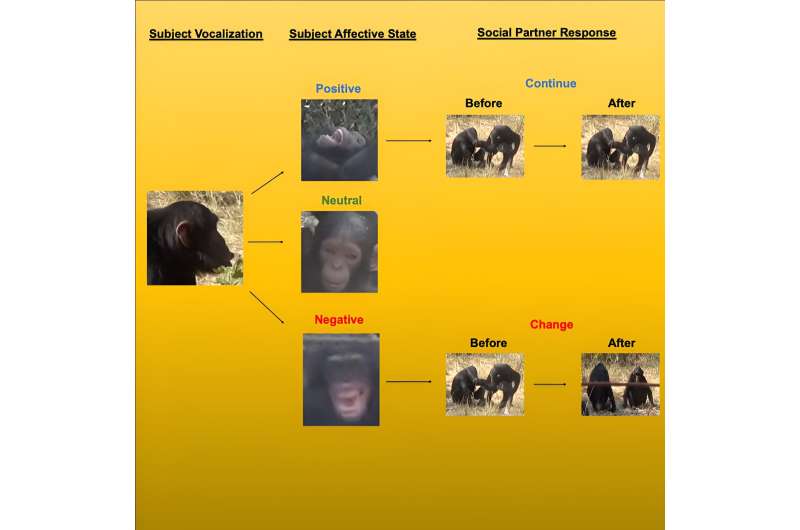This article has been reviewed according to Science X's editorial process and policies. Editors have highlighted the following attributes while ensuring the content's credibility:
fact-checked
peer-reviewed publication
trusted source
proofread
New study reveals similarities in language development between chimpanzees and humans

A new study has provided evidence that young chimpanzees are capable of vocal functional flexibility; a known building block in human language development.
The ability to produce sounds that can fulfill a variety of functions is fundamental to how we learn to speak, but it has long been believed that non-human primates don't share this skill.
Human babies make noises that have specific purposes. Screams, laughs and cries for instance all have a rigid purpose and clear emotion attached to them. But there are other free speech sounds, like pre-babbling, that are more flexible in their function.
New research has found that infant and juvenile chimps demonstrate a similar vocal flexibility, which implies the foundations for speech are rooted in our primate evolutionary heritage.
Lead author, Dr. Derry Taylor, from the University of Portsmouth's Department of Psychology, said, "All living things communicate, but only humans communicate using language. How this came to be is an unsolved mystery within science.
"Until now we didn't have evidence of vocal functional flexibility in non-human primates early on. This discovery holds profound implications for our understanding of the origins of human language."
The paper, published in iScience, is one of the first systematic studies of early chimp vocal production and function.
A team from the University of Portsmouth in England, the University of Neuchâtel in Switzerland, and Université Clermont Auvergne in France, filmed 768 vocalizations in 28 young chimpanzees at a sanctuary in Zambia. These included grunts, whimpers, laughter, screams, hoos, barks, squeaks, and pant hoots.
When reviewing and classifying the sounds, they discovered that similar to human infants, the chimps produced calls with different affective states—positive, neutral, or negative—alongside a variety of facial expressions and movements.
These flexibly expressed call types, particularly grunts, also prompted distinct responses from social partners based on how they were expressed with certain behaviors. The findings demonstrated a clear parallel with existing human infant research.
Co-author Marina Davila-Ross, Associate Professor in Comparative Psychology at the University of Portsmouth, said, "Many studies comparing apes with human children have tested them at different ages in order to discuss differences in language development between both species.
"We mirrored another piece of research carried out in America, which looked at vocal functional flexibility in human infants, to ensure that our research followed a similar methodology and the results could easily be compared.
"These findings contribute to a growing body of literature challenging conventional beliefs about primate vocal production and emphasizes the need for further comparative developmental studies to enhance our understanding of the evolutionary origins of language."
More information: Derry Taylor et al, Vocal functional flexibility in the grunts of young chimpanzees, iScience (2023). DOI: 10.1016/j.isci.2023.107791
Journal information: iScience
Provided by University of Portsmouth





















